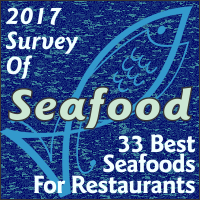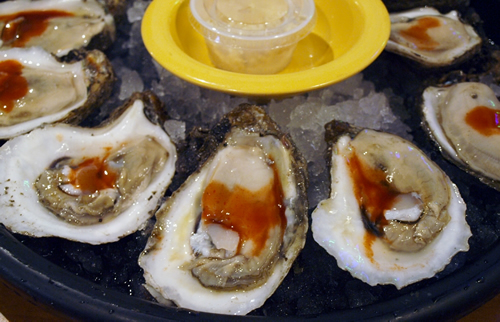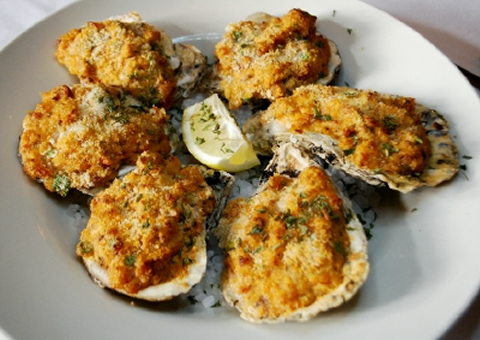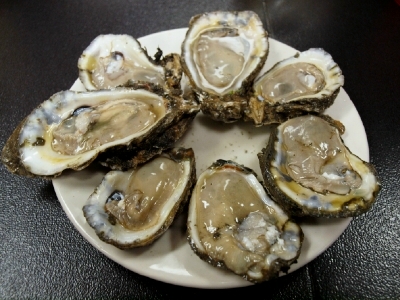 Our annual survey of seafood in Southeast Louisiana comes to a close today, as we conclude a countdown of the 33 best seafood species enjoyed especially in restaurants. Over the weekend, I'll fine-tune the list and post it permanently on the NOMenu website.
Our annual survey of seafood in Southeast Louisiana comes to a close today, as we conclude a countdown of the 33 best seafood species enjoyed especially in restaurants. Over the weekend, I'll fine-tune the list and post it permanently on the NOMenu website.

#1: Oysters
The best assessment of how fine our local oysters are came from Richard Collin, in his last restaurant guide in the 1970s. He gave this recommendation: Best Meal at the Acme Oyster House One Dozen Oysters on the Half Shell; Beer Better-Than-Best Meal at the Acme Oyster House Two or Three Dozen Oysters on the Half Shell; Two or Three Beers Yep. The only thing better than oysters is more oysters. Oysters are, to my palate, the most delectable of all the seafood that comes our way in New Orleans. That has been especially true this year. Even while the oyster fishermen rebuild their beds after surges of freshwater killed a lot of them last year in the battle against BP oil, the oysters that remain have been unusually meaty, firm, salty and delicious. Oyster connoisseurs agree that the best way to eat them is immediately after the shell is opened. Raw oysters on the half shell, despite all warnings about the dangers they present to our health, are the standard presentation. The health warnings are true, although most of the problems affect a small minority of the population. The resource is so easily available that our cooks have dreamed up hundreds of ways to prepare them. Oysters appear in appetizers, soups, salads, seafood entrees, meat entrees. . . everything but dessert. My own favorite cooked oyster dish is oysters Bienville, above. (This batch was at Keith Young's Steak House.)
Oysters are seasonal, but refrigeration on boats and trucks long ago eliminated the need to avoid oysters in non-R months. That said, it must be noted that oysters reach a low point in July, when the warm water makes them leaner than in the cooler months. They shrimp a lot in cooking then. In early summer, the liquor in the shell can get milky--a function of the spawning cycle. Neither of these effects is harmful, and only slightly impact enjoyment.
The resource is so easily available that our cooks have dreamed up hundreds of ways to prepare them. Oysters appear in appetizers, soups, salads, seafood entrees, meat entrees. . . everything but dessert. My own favorite cooked oyster dish is oysters Bienville, above. (This batch was at Keith Young's Steak House.)
Oysters are seasonal, but refrigeration on boats and trucks long ago eliminated the need to avoid oysters in non-R months. That said, it must be noted that oysters reach a low point in July, when the warm water makes them leaner than in the cooler months. They shrimp a lot in cooking then. In early summer, the liquor in the shell can get milky--a function of the spawning cycle. Neither of these effects is harmful, and only slightly impact enjoyment.
 I admit to a local-pride aspect to my love of our oysters. But I've had oysters wherever I've traveled, including the famed Blue Points, Belons, Malpeques, Kumamoto, and Olympia oysters. None of them shows me anything that I find lacking in our oysters at their peak. On the other hand, all of those are much smaller than ours, are expensive, and typically sold a few at a time. To hell with them.
Beyond being delicious, our oysters represent a value. On a weight-per-dollar basis, there is no less expensive seafood. All of this adds up to what, for me, is the Number One seafood resource we have. New Orleans is the place where Americans travel when they decide to eat their first raw oysters.
I admit to a local-pride aspect to my love of our oysters. But I've had oysters wherever I've traveled, including the famed Blue Points, Belons, Malpeques, Kumamoto, and Olympia oysters. None of them shows me anything that I find lacking in our oysters at their peak. On the other hand, all of those are much smaller than ours, are expensive, and typically sold a few at a time. To hell with them.
Beyond being delicious, our oysters represent a value. On a weight-per-dollar basis, there is no less expensive seafood. All of this adds up to what, for me, is the Number One seafood resource we have. New Orleans is the place where Americans travel when they decide to eat their first raw oysters.